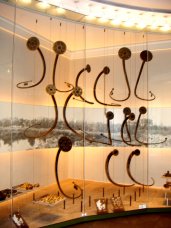A
few definitely metallic objects appear in the legend:
-
Ey-de-Net’s shield;
- Dolasilla’s unfailing
arrows (as a matter of fact, it is stated that her bow is
metallic as well, but this certainly is a later distortion:
ancient metallurgy couldn’t manufacture any object like
that);
- Dolasilla’s armour;
- the arrow that wounds
her and those that kill
her;
- the silvery
trumpets (and the Landrines’
timpenes).
It
can be observed that all and only these objects are defined
as “magic”. It seems, therefore, that metal was
known in the Dolomites in that period, but it was rare, reserved
to greatly prized objects; moreover, the constant use of the
word “magic” as a synonym of “metallic”
probably denotes, more than the attribution of esoteric virtues
to the objects as such, a meaning of the term “magic”
alike to “created by art, not existing in nature”.
This fact alone brings to date the origin of the legend well
before the Roman Age.
Most
metallic objects that appear in the saga are, as expectable,
weapons. We must first clarify the misunderstanding about the
bows, Dolasilla’s and Spina-de-Mul’s,
which are defined as “magic” and therefore “metallic”
or “silvery”, while it is obvious that metallurgy
at that time was lacking the know-how (both about alloys and
the thermal treatments required to confer elasticity) needed
to manufacture such an object, whichever metal might have been
employed. Not the bows, but the arrowheads actually were metallic:
what anyway bestowed upon them a penetrating power quite superior
to that of non-metalllic materials (stone, horn, hardened wood,
maybe flintstone or quartz, provided that it was possible for
the Fanes to get some). We also ventured to put forward the
hypothesis that Dolasilla’s armour
might consist of iron platelets: one of the first appearances
of this metal, the properties and processing of which had still
to be virtually unknown in the area. It is even doubtful whether
it was possible to reach an oven temperature high enough to
smelt iron completely, in order to get rid of impurities. Last,
Ey-de-Net’s exceedingly heavy shield
obviously ought to be a solid or layered bronze casting, while
standard shields were made of wood (as they would be for many
centuries to come), reinforced with bronze finishings at most.
Casting an object like that was clearly out of range for any
itinerant smelter, as it required a large workshop (in the Iliad
we have a parallel in Achilles’ shield, for which Hephaestus
himself is disturbed). More modestly, Ey-de-Net resorts
to the “dwarf
smiths” who lived at the lower end of the Fassa valley,
more or less where we have today the hamlet of Forno
(“Furnace”): an evocative name, even if we know
nothing about the real existence of smelters there at that time.
A last hint must be devoted to helms, a detail that is never
missing in any portrait of warriors of that time, while the
Fanes’ saga never mentions them. A single clue might be
the “diadem”, where the Raietta
was mounted, with which the Fanes’ king crowns his daughter
on Plan
de Corones. As Dolasilla will ever since enter the
field wearing that object on her head, it is quite plausible
that it really was a helm, probably a war trophy.
As
far as music instruments are concerned, we must stress that,
for reasons connected with metallurgy, the “silvery”
trumpets can only be made of bronze (the word “silver”
in the saga presumably means any metal deprived of the yellow-reddish
colour typical of copper, which is instead described as “gold”).
Their presence denies that the legend may be dated earlier than
the middle Bronze Age. They are certainly imported from abroad,
a fact quite plausible in that period of documented long-range
trading. It is also stated that the Fanes’ trumpets are
quite superior to the Landrines’
timpenes
under any aspect. Although there is absolutely no evidence of
it, I like guessing that the silvery trumpets owned by the Fanes
might be a pair of “lurs”,
either original danish, or maybe manufactured in northern Germany
imitating the danish ones. Trading between Baltic and Mediterranean
during the Bronze Age is demonstrated by archaeological findings.
The “lurs”
were bronze trumpets shaped as tapered pipes and bent like mammoth’s
tusks, sometimes over two meters long. Each trumpet of a pair
was bent as a mirror copy of the other. They were manufactured
in pieces that could easily be disassembled and reassembled,
by an investment casting process that allowed walls down to
1 mm thick. Their sound has been reproduced, and it has been
demostrated that they were tenor trombones capable of generating
any note of the scale, with an amazing harmonic effect, specially
when they were blown in pairs.
In
this review of metalworking in the saga, we cannot avoid mentioning
the Vögl
delle Velme. This character, depicted as an expert
metallurgist who has travelled all over the world, outlines
a Bronze Age itinerant smelter exactly, once more a category
whose existence is well documented by archaeological evidences.

"Lurs" at the Copenhagen National
Museum
(photo: Vanin)
|

